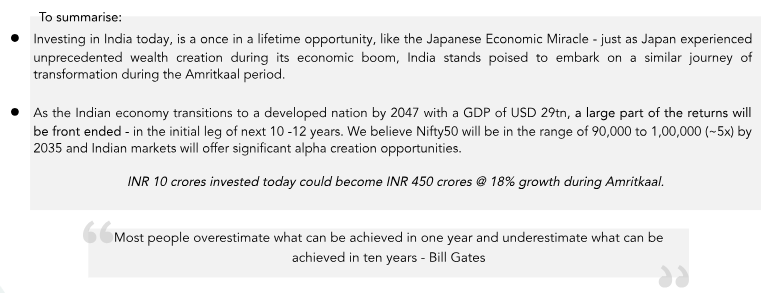It is said when you zoom out and look at something over a longer time horizon, things look much different than when you are zoomed in and looking at narrow time frame. What you choose, determines your approach and outcome. When most people are focused on short term market movements & valuations, we zoomed out and looked at what are the possibilities and probabilities as…
The Indian economy is in a transformative phase and embarking on a journey to become a developed nation by 2047. The country has undertaken robust structural reforms which we believe will drive India’s GDP from USD 3.7tn to USD 29tn by 2047. India’s per capita income is likely to increase from USD 2,600 to USD 18,000.
What makes us believe so?
Decisive and stable political leadership.
Strong foundation laid through structural reforms from 2014-2023 (digital transformation, economic reforms, tax reform, infrastructure reform).
Major Tectonic shifts – biggest reason for our belief in India’s transformative journey
Changing mindset from incremental to “exponential thinking”, with a sense of urgency.
Non-constraint environment – no more thinking like a poor country with resource constraints.
Finding unique solutions to its own problems, “best in class, innovative & technology driven solutions”.
Innovative & scale delivery at low-cost.
Mindset of balancing social welfare & development.
Changing global stature & perception.
Leading to…

Emerging mega trends…
- Youngest & largest working population globally over next 50 years – median age of 28 v/s 38 of China, 2/3rd population will be working class; 25% of global incremental work force will be from India.
- Consumption boom – Largest working population with high aspiration & rising per capita income.
- Factory to the world – Become a major manufacturing hub akin to China in last 30 years.
- Office to the world – Low-cost talent pool with technology to drive “services outsourcing”.
- Sustainability – irreversible & important – Play an instrumental role in guiding the world in ESG.
- Digital hub of the world – Data + AI will be akin to industrial revolution; India will play a key catalytical role.
- Global influencer / Knowledge guru – Play key role in solving global problems, specially of underdeveloped world.
…which will propel structural changes across sectors…
-
- Banking & Financial Services – India’s total credit to grow ~25x during Amritkaal period vs ~20x in last 23 years. Non-credit will see increasing representation in the BFSI space – MF, MSME credit & mortgage credit will be the high growth sectors. In last 23 years, equity market capitalization of the entire sector grew ~100x & PAT ~40x and can offer similar growth opportunities in the Amritkaal period.
- Manufacturing – India’s manufacturing GDP to become ~16x & it’s share in the overall GDP to grow from ~16% to ~28% during Amritkaal period. India is on the cusp of a manufacturing boom (~USD 8tn by 2047) led by Government reforms, cost competitiveness, China/Europe+1 & strong domestic demand. India’s exports to grow ~16x by 2047. During Amritkaal, exponential growth will be seen across sectors – EMS (45x), chemical (19x), defence (10x), pharma (9x), textile (9x) & auto (8x), to name a few.
- Services Export – IT/ITeS services exports to grow 12x by 2047 in Amritkaal period. ER&D within IT/ITeS will grow much faster. ER&D is at a point where Indian IT services was in 2001.Services export to grow 10x by 2047. Travel, tourism, education and space will be key wealth creators in the services sector.
- Infrastructure – Infrastructure set to become the biggest driver for India’s economic growth – government plans to invest USD 1.7tn between 2023-2030. Railways & renewables will lead the infra growth engine. Infra spend will be front loaded in the first 10-12 years – infra spend has multiplier effect on economy. By 2035, the Government plans to spend 4x of last 12 year’s spending on infrastructure. Railways capex estimated to increase ~17x from USD 0.1tn to USD 1.7tn (40% of GDP) during the Amritkaal period.
- Consumption – India’s per capita income to grow ~7x, consumption basket to grow ~9x by 2047. The way India consumes will undergo a massive “Shift”–“more, better, new”. Aspirational middle-income household will drive premiumization across categories. Discretionary spends to grow faster than staples. Food & beverage to grow ~6x by 2047 vs 8x in last 23 years. Healthcare to grow ~14x vs 8x in last 23 years. Consumer durables to grow ~16x vs 8x in last 23 years.
On the back of these trends and structural changes across sectors, India’s corporate profit pool likely to become ~16x (USD 2.5tn) & equity market capitalization ~11x (USD 40tn) by 2047. In last 23 years, corporate profitability grew ~19x and equity market capitalisation grew by ~22x despite lot of challenges likes of GFC, Covid-19, implementation of GST, demonetisation and many more.

Some interesting possibilities during Amritkaal period
- India will see incremental domestic investment of USD 2.3tn & FII investment of USD 1.5tn over the next 10-12 years
- India will have 75+ Fortune 500 companies.
- If ICICI Bank grows at 15% annually, it will cross JP Morgan Bank (USD 3.9tn assets) .
- If SBI MF grows at 21% annually, it will cross BlackRock (USD 9.4tn AUM).
Strong Indian macros – re-rating India – Premium valuations likely to continue & INR might be less vulnerable to depreciation
Stable macros – controlled fiscal deficit, balanced debt to GDP, stable balance of payment (BoP) & record FDI.
Sustainable and balanced growth in all 4 components of GDP:
Consumption, government spending, investments & exports.
Stable currency environment.
Stable, reformist & progressive governance.
India’s CAD of 1.5% – 2.5% of GDP will turn surplus led by:
Import substitution, increased manufacturing export, doubling of services exports, reduced dependency on oil for energy needs.
India is the only emerging country which offers best growth, best ROE and low cost of capital (inevitable recipe for high valuation).
India is standing at an inflection point and is going to experience its “Amritkaal” period over the next 23 years. The underlying currents are very strong. We believe this is the ideal time to invest in India’s Amritkaal and reap the benefits of multi-year compounding.



